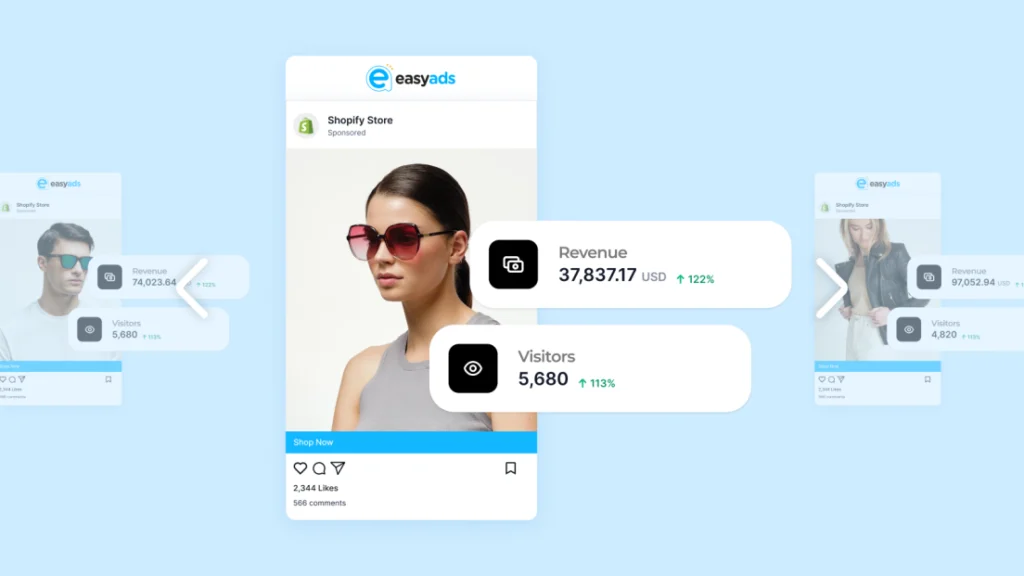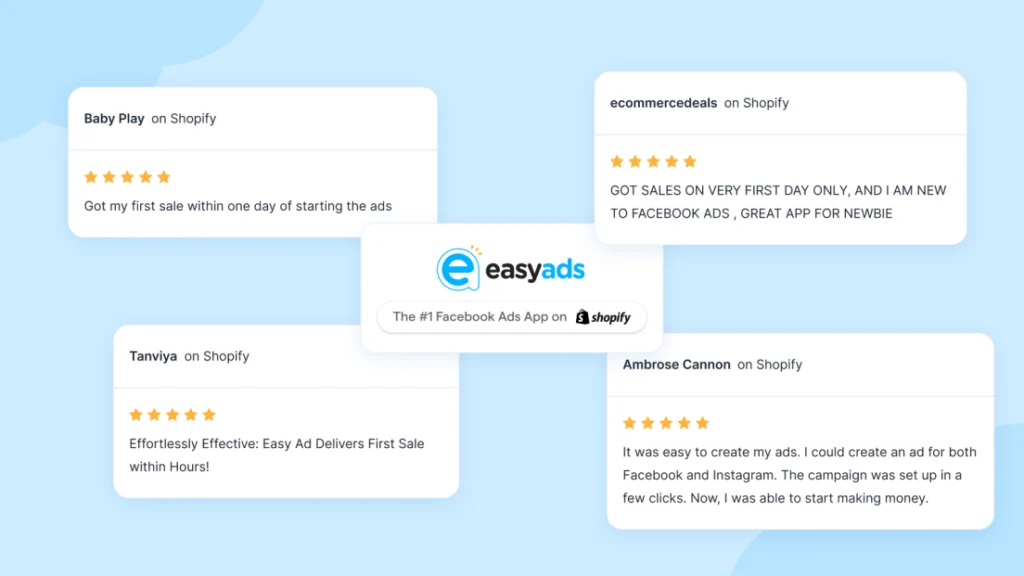Running Facebook ads for Shopify with a small budget can feel impossible when every dollar counts and results seem unpredictable. You spend $20 here, $30 there, and hope something sticks. The problem isn’t your product or your audience. It’s your structure.
If you create Facebook ads for a Shopify store in 2025, you don’t need a huge budget to get results. You just need the right setup and a tool that works with Meta’s algorithm instead of against it.
That’s exactly what Easy Ads for Facebook was built for. You can start campaigns for as little as $10 per day, and even $5 if you’re targeting small audiences.
The app helps you promote all your products, one specific item, or a collection, and then uses AI to match each shopper with the product they’re most likely to buy.
It’s the fastest and cheapest way to test products, find winners, and start scaling.
Get Sales with Small Budgets
Experience Easy Setup, Faster Scaling, and Higher ROAS.
Try Easy Ads today for FreeWhy Facebook Ads Still Matter in 2025
With TikTok, YouTube, and new ad platforms popping up every year, it’s easy to assume Meta ads are past their prime.
But the numbers highlight that Facebook ads for Shopify are still a necessity, even with a small budget.

Meta’s ecosystem still dominates e-commerce advertising because it combines huge audience reach with data-driven precision. Most Shopify stores still make their first sales through Facebook and Instagram — and many continue to scale profitably there long after.
In 2025, Facebook’s algorithm is smarter than ever. It automatically learns who your best customers are and where to find more of them. The goal isn’t to outsmart the algorithm anymore. It’s to feed it the right data so it can do the work for you.
The Truth About Small Budgets
A small budget doesn’t mean small potential. It means you have to structure your campaigns so that every dollar works harder.
Too many merchants make the same mistakes when running low-budget ads:
- Spreading their spend across too many products
- Testing too many audiences at once
- Turning off campaigns before they’ve gathered enough data
The trick is to keep things simple. When you focus on one product or one goal at a time, Meta can learn faster and optimize efficiently.
You don’t need 10 ad sets and five audiences. You need one clean campaign with a clear objective.
Step 1: Pick One Clear Goal
If you’re new to ads or restarting from scratch, the first step is choosing a single campaign goal.
For small budgets, these are your best options:
- Sales (Conversions): If your pixel already has a few purchases.
- Traffic (Landing Page Views): If your store is new and doesn’t have conversion data yet.
Once you pick your goal, stick with it for at least seven days. Changing objectives mid-way resets learning and wastes money.
If you’re using Easy Ads for Facebook, the app automatically picks the right campaign structure for your goal, so you don’t have to worry about setup.
Turn $5/Day Into Profitable Sales
Easy Ads helps you get higher ROAS even with a small budget.
Try Easy Ads today for FreeStep 2: Start With One Product or Collection
When you’re working with limited spend, promoting everything at once isn’t efficient. It’s better to test one product or a small collection at a time.
The idea is to give Facebook’s algorithm a clear signal. The more focused your campaign is, the faster it learns who to target.
If you’re not sure where to start, choose a product that:
- Already converts organically
- Has a clear visual appeal
- Falls in the £20–£100 range (the sweet spot for impulse buys)
Easy Ads for Facebook gives you flexibility here. You can run ads for one specific product, a whole collection, or even your entire catalog. The AI will automatically match each person with the product they’re most likely to buy, so nothing is wasted.
Step 3: Keep Your Budget Tight but Consistent
You don’t need big budgets to make progress. What matters most is consistency and smart marketing strategies.
If you can afford $10 a day, that’s enough to generate data and test your offer. Even $5 can work for smaller audiences or retargeting.
What you shouldn’t do is pause campaigns every few days or keep changing budgets. Facebook’s learning system needs stability to optimize properly.
If you’re using Easy Ads, the app keeps your budget consistent while automatically shifting spend toward the products and audiences that perform best.
Step 4: Focus on One Campaign Structure
When you’re running small-budget ads, simplicity wins.
Here’s a structure that works:
- One campaign
- One ad set
- Two to three ad creatives
That’s it. This simple helps you avoid many common Facebook ads errors.
The goal is to make sure your budget isn’t spread too thin. When you use Easy Ads for Facebook, the app automatically builds this structure for you — optimized for conversions and compliant with Meta’s latest best practices.
Step 5: Use Creatives That Stop the Scroll

Your creativity is the first thing people notice. On a small budget, it matters even more because you have fewer chances to make an impression.
A few simple creative tips that work in 2025:
- Use short product demos instead of static images
- Add captions to every video (most users watch without sound)
- Show real customers using your product
- Keep text short and focused on the problem you solve
If you don’t have professional footage, don’t worry. User-generated videos, simple screen recordings, or a quick product demo filmed with your phone often perform best.
According to small-business video marketing experts, authentic content drives stronger engagement and can outperform highly polished productions if done right.
Step 6: Watch the Right Metrics
When you only have $10–$20 a day, you don’t have room for guesswork. Focus on the numbers that actually help you improve performance:
- ROAS (Return on Ad Spend): Your main success metric.
- CPP (Cost per Purchase): Shows how efficiently you’re acquiring sales.
- CTR (Click-Through Rate): Reveals whether your ad catches attention.
- Frequency: Helps you avoid showing the same ad too often.
If your click-through rate is above 1% and your cost per purchase is dropping, you’re doing things right.
With Easy Ads for Facebook, you get all these metrics in one dashboard without logging into Ads Manager.
If you want to see what this looks like in practice, check out this short video. It walks you through what happens after you launch ads, breaks down Meta’s learning phase, and shows how to use CTR to fine-tune your campaigns.
When you launch your ads, don’t expect them to go live right away. First, Meta reviews each ad. This takes anywhere from a few hours up to a day—sometimes it drags out to 72 hours. If you spot strange bot traffic from places you didn’t target, don’t stress. That’s just Meta poking around your site. You don’t pay for it.
Once your ad passes review, it enters what Meta calls the “learning phase.” Here’s where things get a bit rocky. Your performance numbers will jump around, and costs tend to be higher at first. Meta is figuring out who’s actually interested in your ads. This phase ends after your campaign hits about 50 optimization events.
A few things make this phase harder than it needs to be: Don’t constantly tweak your ads, don’t underfund your campaigns, and don’t run a bunch of campaigns that chase the same audience. These mistakes throw your results off and stretch out the learning phase.
Now, let’s talk about what really matters: your click-through rate (CTR). Forget the noise for a moment and focus on this one number. Wait a full week, then check your CTR. You want to see at least 2%.
If your CTR’s under 2%, your ad creative, images, or targeting need work. If it’s above 2% but you’re still not getting sales, your ads are doing their job—so shift your attention to your website, your prices, or your checkout experience.
Tweak your campaign, let it run for another week, and check again. That’s how you get your ads on track.
Step 7: Let Automation Do the Hard Work
When you’re working with small budgets, you don’t want to waste time micromanaging. That’s where automation gives you an edge.
Easy Ads for Facebook automatically creates, tests, and optimizes your campaigns. Its AI finds the best audiences for your products, adjusts spend, and stops weak ads before they waste your budget.
You can promote all your products at once, or narrow down to one collection. The app makes sure every ad reaches the people most likely to buy each item. This is a huge advantage when you create Facebook ads for Shopify and use a small budget.
That means faster results, cheaper testing, and better data — without having to manage campaigns manually.
For a deeper look at how Shopify ads automation works, see Shopify Ads Automation: The Smarter Way to Run Ads and Grow Sales in 2025.
Step 8: Be Patient, Not Passive
Even with automation, results take time. Facebook’s algorithm needs a few days to gather data and learn. Don’t panic if sales don’t show up on day one.
A good rule of thumb is to let your campaign run for at least five to seven days before making changes. Once the data starts rolling in, you’ll know which creatives and products deserve more budget.
The stores that grow fast aren’t the ones that spend the most — they’re the ones that stay consistent.
Why Easy Ads Is Perfect for Small Budgets
Most Shopify stores waste money on complicated setups or inconsistent testing. Easy Ads for Facebook solves both.
You can run Facebook ads for your Shopify with a budget as little as $10 per day, or $5 for smaller audiences. The app uses AI to automatically find the best audience for each product and match people with what they’re most likely to buy.
That makes it the fastest, most affordable way to test products and identify winners. Many merchants get their first sale within hours of using the app, and Easy Ads consistently ranks #1 on the Shopify App Store with highly positive reviews.

If you want to grow your store without overspending, this is where you start.
Final Thoughts
You don’t need a big budget to run profitable Facebook ads. You need structure, consistency, and a system that does the heavy lifting for you.
With Easy Ads for Facebook, you run Facebook and Instagram ads for Shopify, test products quickly, scale what works, and run ads that actually sell — all without living inside Ads Manager.
Start small. Stay consistent. Let automation handle the rest.
That’s how small budgets turn into real growth.
FAQs
What’s the minimum budget I need to run Facebook ads?
You can start with $10 per day, or even $5 if you’re targeting a small audience.
How long should I run my ads before making changes?
At least 5 to 7 days. Facebook’s algorithm needs time to learn and optimize.
Can I advertise multiple products at once?
Yes. Easy Ads lets you promote all your products, a collection, or a single product in one campaign.
How long does it take to see results?
Many users see their first sale within a few hours of launching campaigns with Easy Ads.
Is Easy Ads for Facebook good for beginners?
Yes. It was designed for Shopify merchants who want results without needing expert-level ad knowledge.
Stop Wasting Money on Facebook Ads
Get better results with smarter targeting and automation.
Try Easy Ads for Free Today
Leave a Reply